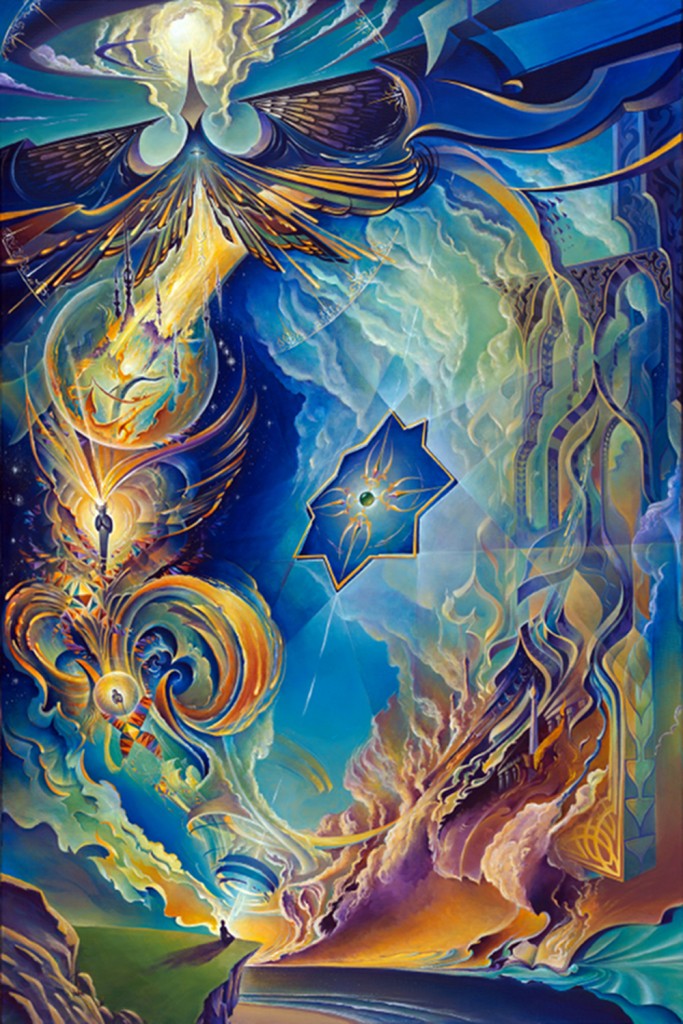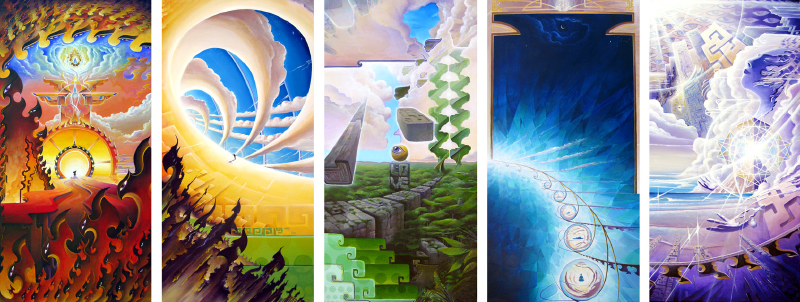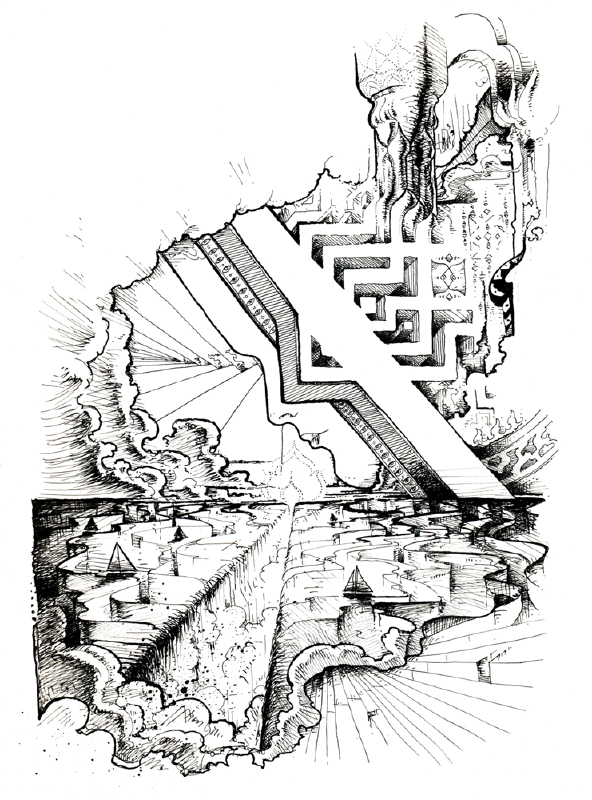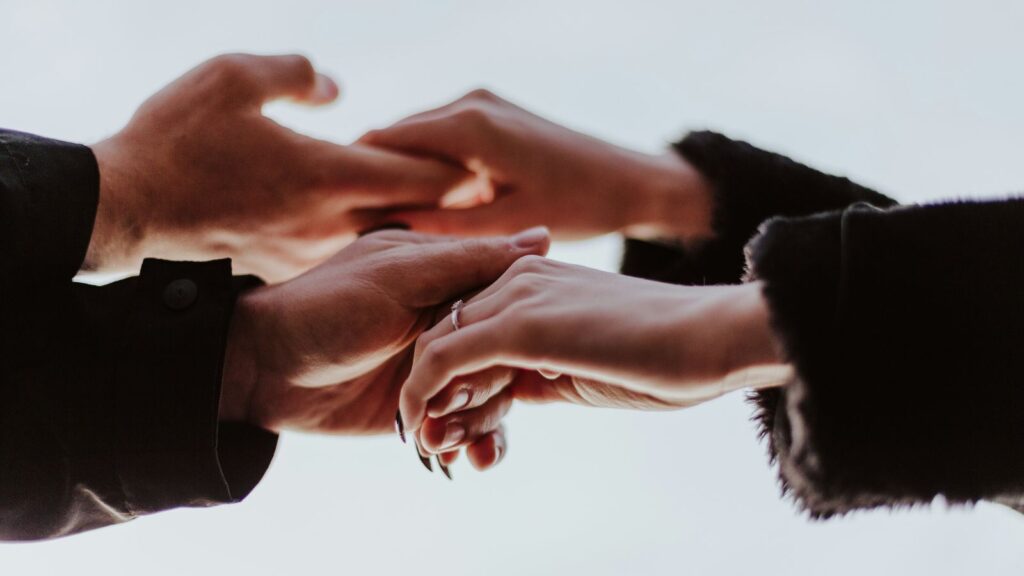Contemporary Visionary Art has come to be associated with global festival culture, but more importantly it is a movement that bridges both the myriad historical art movements as well as more ancient mystical artistic practices. Persevering through changes of context and technology, this motley lineage of artists shares a commitment to exploring consciousness and our place in an ecological cosmos. These artists remind us that unseen dimensions are only obscure to our material eyes, and that through the creation and appreciation of art, we can awaken to and realize our fullest potential.
Among the newer iterations of visionary artists – a cohort that includes Amanda Sage, Luke Brown, Adam Scott Miller, and Andrew “Android” Jones – Michael Divine has carved out a niche all his own. His evolving style is unmistakeable even from a distance: sweeping vistas, vaulting archways, and numinous geometries establish epic scales of wonder and discovery, while stylized figures express an emotional intensity that seems incongruous with the simplicity of their forms. Energetic tendrils and cloudy billows are pierced by sharp lines and distinctive edges — contrasts of form that mirror the juxtaposition of colors, which often arrive in a mix of pastels: coral and turquoise, sunset golds and royal violets. The total compositions are encounters with – not just depictions of – divine insights and profound meditation. Viewers enter the fold of a capacious awareness that strikes viscerally, at the gut level, resulting in a transference of epiphany.
For the first time, a representative selection of Michael Divine’s artwork from the last 16 years is available in book form. Full-color reproductions of his best-known paintings – “Glass Onion”, “Birth of a Star”, and the Evolution series among them – sit beside early works and never-before-seen studies, providing insight into the artist’s development and creative process. The short accompanying essays are not so much /about/ the artwork as they are explorations of – and reflections on – the creative energies embodied therein. In focused meditations on growth and change, purpose and persistence, the artist contemplates his path with humor and humility.
In conversation, Michael Divine elaborates on his intentions:
You make the case for painting’s ongoing significance in your book. To take one of the questions you ask in it (“So, why paint?”) another step further, could you tell us: So, why produce this book? And why now?
Well, if I didn’t make a book now, then I would just have too many paintings–the book would just get thicker and bigger. But, to be honest, it really just felt like the right time. We’d made a few previous attempts but they didn’t pan out due to issues with publishers. In retrospect, I wasn’t ready. Now, today, I’ve been able to write much more clearly than in any of my previous attempts and, in doing so, I can present something that I feel is much closer to the core of who I am and what I’m trying to say than something I might have made 5 or 6 years ago. Besides all of that, my work, at that time, wasn’t ready for it. I’ve come much further as an artist and, I think, some of my best work has come about over the past 5 years.
It was Violet’s idea to publish it ourselves via fundraising and pre-orders. When we gave it some thought, it just made sense – everything was there. I think that’s the case with many things. If it’s the right time – if things seem to line up properly – then it can be pulled together. It just takes some effort, dedication, etc.
So, really, the time was just right, and so here it is.
The Myth of Freedom
How do you see the role of the painter in 2013?
Let’s talk about the hand-held brush for a moment – the canvas, the paint, etc. I think that, in this day and age, where our computers do all kinds of stuff for us and we can do all kinds of stuff through them, people are sometimes amazed that I make my work without any computers at all – that it’s all by hand. I think that’s important, and that it jogs something in people – this possibility of the human experience. The expansiveness, the openness, the richness of color and dynamism – these are things which I sort of just conjure up out of myself and put onto the canvas through a medium that isn’t new or assisted with effects and whatnot.
The role of the painter – and the artist, in general, I think – is to find those spaces – those deep personal experiences and ways of relating – and share them with others. It’s to be the mirror that much of our society – with its constant consumer blitz – is not. It’s to be raw and open and free and find ways to express and explore that. I think that this has always been the job of the artist. Some things don’t change much…
The Glass Onion
Shifting gears for a moment from the ways that art has remained the same – are there any currents which an artist can tap into today that perhaps weren’t as pronounced ten or twenty years ago?
Well, obviously the internet is a huge one. When I was in my early 20s there was no internet to speak of. I mean – it existed and I had a website I made with Front Page and it was a kludgy, janky thing. There was email and all that, but even digital cameras were rare…. There wasn’t this almost instantaneous ability to share with a broader community. I think that has its pros and cons: younger people sometimes seem like they are in a rush to produce. Admittedly, I felt I was just off on my own making art in Vermont, where I lived then. It allowed me to develop my own voice in a more personal way.
Another big shift is the injection of the visual arts into the festival scene. It’s great to see art galleries, a plethora of live painters, and all sorts of stuff…. It’s sort of bled out from the West Coast – from Tribe13 and others – as well as from the Burning Man culture. There’s this higher valuation of the visual arts that’s really prevalent right now – the FORM the festival takes as much as the musical content. That makes me really happy. Festivals, over the years, have changed from being Music/Vendor/Camping with whatever other pockets one can find and into these amalgamations of Music/Art/Interactivity + all the other usual stuff.
Evolution Series
In addition to the integration of your work into these festivals, do the festivals circle back to inspire your work? What would you characterize as being among your greatest sources of inspiration?
My greatest source of inspiration: Life. I realize that’s pretty broad and maybe seems trite to just say it like that… but it’s true. This vast human experience. The heights, the depths, the whole spectrum. And everything else. I find inspiration while hiking, dancing, driving on the freeway, sitting and drinking a coffee, listening to the birds…. All sorts of things, and they all feed into it.
If I were to sort of drill down and choose one particular thing that I find inspiring, I’d say that dancing to music that makes me move is a huge source of inspiration. To be filled with movement and openness allows my heart and mind to have this sort of unfettered access with the world around me – sometimes to new ideas and new views of things.
Given these interests, what draws you to visual art in particular? Have the sources of attraction evolved over your years as a painter?
Visual art, for me, is a mode of expression that allows for this long term exploration of an idea or feeling through a wordless space. A finished painting doesn’t require any long explanation – or any words whatsoever, really. It can just be what it is. It can go through formed and formless ideas and feelings and all sorts of spaces, conjuring up an over-arching sensation. I think that’s what really attracted me early on – [[[colon instead of hyphen]]] there was a visceral quality that I felt I could translate onto the paper or the canvas that could move beyond words. In that, though, there is this deep love for what I do – to see a piece through from start to finish and be able to realize ideas, impossible spaces, things that turn my brain inside out… that is something I really truly love to do.
I also love the sharing part: visual art is so immediate. Not to compare one to another, but literature, music – these things require a longer term engagement. You need to actually read the book or listen to the music and commit to a certain length of time for that experience. Visual art is BAM – there it is [[[comma]]] and, [[[omit comma]]] generally, within a minute you know if you like it or don’t like it. Granted, I have a ton of books and listen to a ton of music – they all go hand in hand. But with visual art, I love the immediacy of the ability to share it.
Speaking of visceral/visual art – art that doesn’t need explanation – how did you select the words to pair with the paintings in your book? In the introductory remarks, the editors lament the pervasive intellectualization of art in certain mainstream circles, where paintings need to be justified by companion texts that appeal to the rational mind of analytical interpretation. Along these lines you mention, the editors admire visionary art as “a movement that dares to speak directly to the viewer” through an immediate, affective encounter. If the text is not deconstruction or analysis of the art, how would you characterize it?
You’re right – this isn’t the kind of art book with long narratives of analytical exposition. I felt more like I wanted to give the reader a sort of visual sense through words. Words are signposts – they can never mean the same thing for each person. But they can help direct one towards an idea of the emotion or experience that we are having. So the words act as a glimpse into the thought process of myself, the creator of the paintings. The thing about the over-intellectualization of contemporary art is that it’s so obtuse and vapid that it’s true value often has to be talked up because otherwise it’s just what? A row of dots on a canvas? A shark submerged in formaldehyde? It becomes art for art’s sake and doesn’t seem to have any meaning or use – or, quite often, inspiration – until that has been ascribed to it. We weren’t interested in creating additional explanations that ascribed value or walked a person through a painting or, in any case, assigned some intellectualized ideas to it. We felt that the work could speak for itself and that this allowed people to have their own experience with it. Instead, the writing acts more as a prelude: something to set the mood and tone for each particular section.
If not aligned with postmodern formaldehyde, what larger movements do you see your art intersecting? Do you envision your artwork in the context of any particular art historical movements?
I think that all art, if it’s really doing something, is part of a larger dialogue. The art we make today is informed by what came before… Before ‘Visionary Art’ there was ‘Psychedelic Art’ and then, going backwards, Surrealism and, in sort of a big melange – Dadaism, Futurism, Cubism, and back to Impressionism and Symbolism, which was where the first big shift happened. The larger movement, though – the thing that ties these together – has been a desire by artists to understand more deeply how we see – and, in some ways, to slowly turn the gaze inwards. Before the last hundred and fifty years of art there was little in the way of ‘imagination’ in painting. Most everything was simply reimagined religious and mythical scenes, great battles, etc, or it was portraits and still lifes and landscapes. The schools of art didn’t allow for much outside of that. But that was where we were at in the broader context of understanding our place in time and space, understanding identities and social structures, etc. There’s been a huge shift in this last hundred and fifty years with the Industrial Revolution and then new ways of thinking in psychology, physics, philosophy – not to mention drugs and music and all kinds other things – and it’s helped to crack us open in completely new ways.
Visionary Art is, I think, a great metric by which to measure that movement and growth because, as a mode of expression and when it’s successful, it can get past the stories – the preconceived symbols and myths – and express something that is beyond words and lies deeply rooted in the archetypal mystical experience. It is as if we’ve glimpsed the ability to express the brightness of the inner sun that is the mirror of – and just as bright as – the outer sun.
Without relying on preconceived symbols, how do you decide on the subjects of new paintings?
When I’m thinking about what I want to paint, I consider what I want to spend my time doing. I look through sketchbooks and find what seems worthwhile. Other times, I just have an idea one day and it seems to be worth exploring. If it’s going to be a large painting: I don’t want to waste 3 or 4 months on something that my heart isn’t into. So it has to be something where I see the possibilities of something unique, something tangible, and something that seems a worthwhile addition to the world at large, and something that seems worth exploring. I always have a sketchbook with me. The sketchbook gets filled with ideas, inspirations, a bit of this and that – feelings and visions. Usually, along the way, I have an idea of something that really intrigues me. I make more drawings of it and break down the individual parts and pieces and consider it from different angles. I think about those pictures a lot. I think about how they fit into the context of what I want to explore and then, usually, I turn some of those into paintings. But, like I said, there’s only so much time ever – so I try to find the ones that I think are the most worthwhile. Along the way, a lot of drawings are turned into smaller paintings just because I love to paint and it’s all part of the dance.
Where do you like to create all this art? Does the experience of live painting in front of an audience differ from painting in your studio?
Well, my studio is my favorite place: the sound – the speakers and the stereo – is just right; the light, the openness…. It all fits and is always laid out to be optimal for painting.
It’s certainly different with live painting, which I also enjoy – the music and intensity of a crowd, and all of that. I give a lot of thought to live paintings and like to be able to see something through from start to finish when I’m painting in front of a crowd. I think it’s magical to share that with others – the entire process, from a blank canvas to the final touches.
Granted, to be able to explore the nuance and the brushstrokes and everything – that takes time and I think that, ultimately, I make better work in the studio. I think this is true for most artists. Live painting is a great way to go play, express, and share. But to really make great works of art, the studio, the personal time – the work we do when no one is watching – that is where the real magic happens.
Where do you see yourself going in the next few years?
Well, there’s a few irons in the fire…. The book project is just step one of a larger vision…. But more on that another time. There’s a clothing line in the works, as well…. And right now I’m working on some pieces that are, I think, a bit darker than previous work and slant more in the direction of social commentary. It’s important for an artist to not lose sight of the here and now. The fanciful visions are nice, but if they aren’t grounded in reality then they lose their substance. I also have some children’s books that have been in the works for a long time, which I’d like to bring to completion. You know – there’s always new projects, collaborative and otherwise – new paintings, new explorations. I like to leave myself pretty open. However, the thread that’s run through it all – through the last 20 years of my life – making art…. That never changes.
Thanks so much for taking the time to share your vision. Where can people go to order a copy of your book?
The book can be ordered directly from my website, tenthousandvisions.com: http://tenthousandvisions.com/store/prints/the-artwork-of-michael-divine/
















